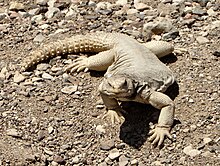Uromastyx aegyptia
| Uromastyx aegyptia | |
|---|---|
 |
|
| Scientific classification | |
| Kingdom: | Animalia |
| Phylum: | Chordata |
| Subphylum: | Vertebrata |
| Class: | Reptilia |
| Order: | Squamata |
| Suborder: | Iguania |
| Family: | Agamidae |
| Subfamily: | Uromasticinae |
| Genus: | Uromastyx |
| Species: | U. aegyptia |
| Binomial name | |
|
Uromastyx aegyptia (Forskål, 1775) |
|
| Synonyms | |
|
|
Uromastyx aegyptia is a species of lizard in the family Agamidae. The species is endemic to North Africa and the Middle East.
Common names for U. aegyptia include Egyptian mastigure, Egyptian spiny-tailed lizard, Leptien's mastigure, Egyptian Uromastyx and Egyptian dabb lizard.
U. aegyptia is one of the largest members of the genus, with average lengths of 76 cm (30 in) for males.
Egyptian Mastigures can be found in Egypt,Libya, israel and throughout the Middle East but is rarely found today due to reduction of habitat. The remainder of the population mostly inhabits the gravel plains of northern Oman and some parts of the eastern UAE where it is listed as endangered and slowly vanishing due to the impact brought on by development.
Three subspecies are recognized, including the nominotypical subspecies.
The subspecific name, leptieni, is in honor of German herpetologist Rolf Leptien.
This lizard is locally known to the Arabs as 'Dhab' Arabic: 'ضب'. Its strong skin made good leather for the bedouins, while its meat was often considered as an alternative source of protein.
U. aegyptia lives in dry, rocky areas.
...
Wikipedia

